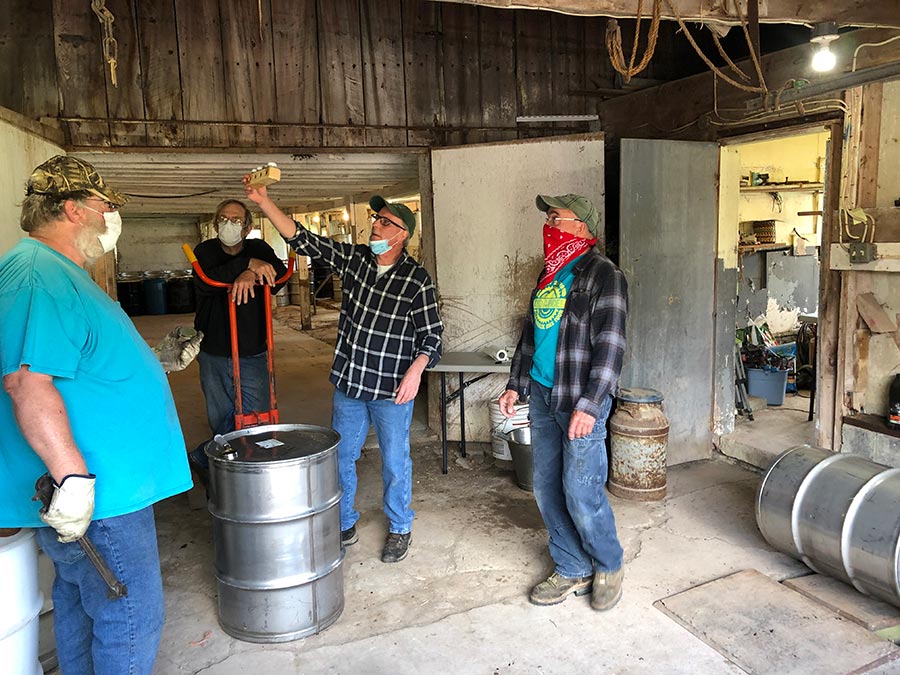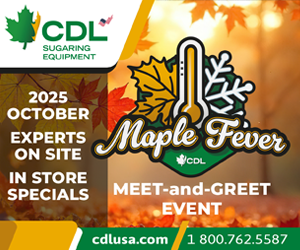Cornell Corner
Grade Blending – a new calculator to get your syrup in grade
Cornell researchers offer new online tool to mix your syrups
By AILIS CLYNE TECHNICIAN, CORNELL MAPLE PROGRAM CORNELL UNIVERSITY, DEPARTMENT OF NATURAL RESOURCES | OCTOBER 7, 2020
VAN ETTEN, N.Y.—Have you ever wanted to blend two syrups of different grades to meet your customers’ needs?
The Cornell Maple Program has developed a new user friendly tool to calculate how many gallons of each syrup you would need to blend.
This calculator will only help those of you using digital light meters that give you the percentage of light transmittance (%Tc) through your syrup.
It won’t help if you use a visual kit.
Let’s go over the grades.
% Transmittance for each grade:
Very Dark
0-24.9%
Dark
25-49.9%
Amber
50-74.9%
Golden
75-100%
It may seem counter-intuitive that as the syrup gets lighter in color, its %Tc number goes up.
This is because the number indicates how much light is allowed to pass through the syrup.
Think of Golden syrup as a white curtain, and Very Dark syrup as a thick black curtain. Which one allows more light to pass through?
To use the calculator, you will need to know:
•The %Tc of your lighter syrup
•The %Tc of your darker syrup
•The %Tc of a 50/50 blend of the two syrups (create a small sample that is half and half of each syrup, and combine thoroughly before measuring %Tc)
•The %Tc you want your final syrup to be, and how much you wish to make
This calculator produces a very close estimate, resulting in a blend that will get you within about 2 points of your goal.
Additionally, all light meters carry some built in error.
To compensate, you should choose a target %Tc that is well within the grade you’d like to achieve.
For example, if blending a Golden Syrup with a Very Dark to make Dark syrup, you should choose a target %Tc of somewhere between 35-40% to enter into the “desired %Tc” cell of the calculator.
To make sure the calculator’s results are as accurate as possible, there are a few steps you can take.
Be sure to follow the instructions and calibration guidelines that come with your light meter.
Also, make sure that any syrup samples you are measuring have had time to allow all bubbles to settle out.
Be patient; this can take a while.
Even tiny air bubbles reflect a lot of light, and therefore make your syrup read darker than it truly is.
This tip is especially important for measuring the %Tc on your 50/50 blend – after thoroughly mixing the two syrups together, your sample will be full of air bubbles.
You may be able to get your syrup in grade by blending, but can you keep it in grade?
New research is revealing that the traditional plastic jugs allow syrup to lose grade rather quickly after it has been canned.
This is because the plastic has microscopic pores that allow oxygen to pass through.
The oxygen induces a chemical reaction that causes syrup to darken, just like how an apple browns after you bite into it.
But the traditional jugs are not the only containers that allow syrup to lose grade.
In fact, the only packaging options that will protect your syrup from darkening are Glass and oxygen-barrier plastics such as the plastics commonly used for squeeze bottles.
If you want to be sure your syrup is in grade for judging at a local or the state fair, you should can your syrup into these oxygen-proof materials, or be sure to can it a day or two before the event.
You can access the Grade Blending Calculator, and many others, at the new “Maple Calculators” page on the Cornell Maple Program Website.
The documents can be downloaded for offline use, or used directly on the site, even on a mobile phone!
Visit www.cornellmaple.com for a variety of maple resources and free materials.

































